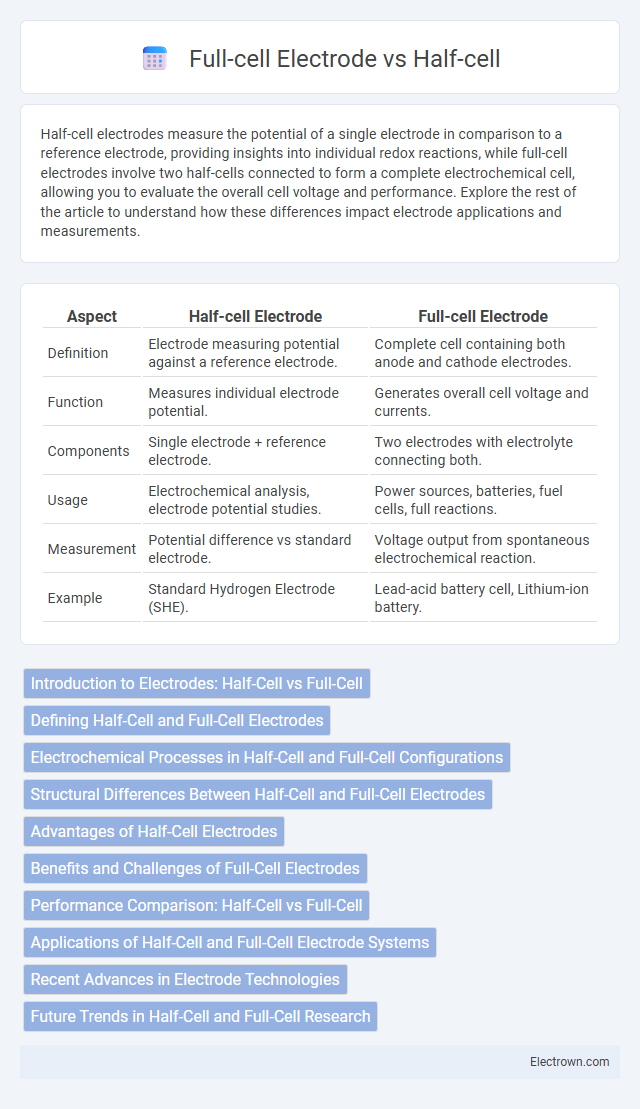Half-cell electrodes measure the potential of a single electrode in comparison to a reference electrode, providing insights into individual redox reactions, while full-cell electrodes involve two half-cells connected to form a complete electrochemical cell, allowing you to evaluate the overall cell voltage and performance. Explore the rest of the article to understand how these differences impact electrode applications and measurements.
Table of Comparison
| Aspect | Half-cell Electrode | Full-cell Electrode |
|---|---|---|
| Definition | Electrode measuring potential against a reference electrode. | Complete cell containing both anode and cathode electrodes. |
| Function | Measures individual electrode potential. | Generates overall cell voltage and currents. |
| Components | Single electrode + reference electrode. | Two electrodes with electrolyte connecting both. |
| Usage | Electrochemical analysis, electrode potential studies. | Power sources, batteries, fuel cells, full reactions. |
| Measurement | Potential difference vs standard electrode. | Voltage output from spontaneous electrochemical reaction. |
| Example | Standard Hydrogen Electrode (SHE). | Lead-acid battery cell, Lithium-ion battery. |
Introduction to Electrodes: Half-Cell vs Full-Cell
Half-cell electrodes consist of a single electrode immersed in an electrolyte, serving as a reference or working electrode in electrochemical measurements. Full-cell electrodes combine both the anode and cathode within the same system, enabling complete redox reactions for practical battery applications. Understanding the differences between half-cell and full-cell configurations is essential for optimizing Your electrochemical experiments and energy storage solutions.
Defining Half-Cell and Full-Cell Electrodes
Half-cell electrodes consist of a single electrode immersed in electrolyte solution, serving as a reference or test electrode in electrochemical measurements. Full-cell electrodes combine both the working and counter electrodes within a single electrochemical cell, enabling complete redox reactions to be studied under operational conditions. Understanding the distinct roles and configurations of half-cell and full-cell electrodes is crucial for accurate measurement of electrochemical properties and battery performance analysis.
Electrochemical Processes in Half-Cell and Full-Cell Configurations
Electrochemical processes in half-cell configurations involve a single electrode immersed in an electrolyte, where the redox reaction occurs and is often measured against a reference electrode to determine electrode potential. Full-cell configurations consist of two electrodes (anode and cathode) connected through an external circuit, allowing electron flow to generate electrical energy during simultaneous oxidation and reduction reactions. Understanding these processes helps you optimize battery design by balancing reaction kinetics and minimizing energy losses in practical applications.
Structural Differences Between Half-Cell and Full-Cell Electrodes
Half-cell electrodes consist of a single working electrode paired with a reference and counter electrode to analyze electrochemical reactions, while full-cell electrodes integrate both anode and cathode within the same system to simulate practical battery operation. Structurally, half-cells often feature a simplified setup allowing precise measurement of individual electrode potentials without interference from complementary electrodes, whereas full-cells require a balanced assembly ensuring effective ion transport and charge transfer between distinct electrode materials. The design of full-cell electrodes prioritizes interfacial stability and material compatibility to optimize overall device performance, contrasting the isolated testing environment inherent in half-cell configurations.
Advantages of Half-Cell Electrodes
Half-cell electrodes offer enhanced precision in electrochemical measurements by isolating the working electrode's potential relative to a stable reference, minimizing interference from cell components. These electrodes provide reliable reproducibility and are essential for studying single-electrode processes in environments like corrosion testing and sensor calibration. Their design enables easier troubleshooting and calibration compared to full-cell configurations, ensuring greater accuracy in experimental data.
Benefits and Challenges of Full-Cell Electrodes
Full-cell electrodes provide the advantage of practical application testing since they include both the cathode and anode, allowing for accurate measurement of real battery performance such as capacity, energy density, and cycle life. They face challenges including increased complexity in fabrication, potential imbalance between electrode materials, and difficulties in isolating individual electrode characteristics. Despite these challenges, full-cell testing is essential for evaluating commercial viability and identifying degradation mechanisms in actual battery conditions.
Performance Comparison: Half-Cell vs Full-Cell
Half-cell electrodes provide detailed insights into individual electrode reactions, allowing precise evaluation of electrochemical performance such as capacity, stability, and kinetics. Full-cell electrodes integrate both anode and cathode, offering a comprehensive view of real-world battery performance, including energy density, cycle life, and efficiency under operational conditions. Your battery optimization benefits from combining half-cell data for electrode development with full-cell testing to validate overall system performance.
Applications of Half-Cell and Full-Cell Electrode Systems
Half-cell electrode systems are primarily used in electrochemical analysis and sensor development, enabling precise measurement of electrode potentials and facilitating calibration in research laboratories. Full-cell electrode systems find widespread application in energy storage devices like batteries and fuel cells, where their ability to generate electrical power through redox reactions is critical for portable electronics and renewable energy integration. The distinction in applications highlights half-cells' role in fundamental electrochemical studies and full-cells' function in practical energy conversion and storage technologies.
Recent Advances in Electrode Technologies
Recent advances in electrode technologies have significantly improved the efficiency and durability of both half-cell and full-cell electrodes, particularly through the development of novel nanostructured materials and composite coatings that enhance electrochemical performance. Researchers have optimized half-cell electrodes to achieve higher selectivity and faster reaction kinetics, while full-cell configurations benefit from integrated designs that minimize internal resistance and enhance cycle stability. Your energy storage systems can now leverage these innovations to achieve higher power densities and longer operational lifespans.
Future Trends in Half-Cell and Full-Cell Research
Future trends in half-cell and full-cell research emphasize improving electrode stability and energy density through novel materials such as solid-state electrolytes and advanced catalysts. Enhanced computational modeling and in situ characterization techniques accelerate the understanding of electrochemical interfaces and degradation mechanisms. This progress drives the development of next-generation batteries with longer lifespans, higher efficiency, and better safety profiles for applications in electric vehicles and grid storage.
Half-cell vs Full-cell Electrode Infographic

 electrown.com
electrown.com